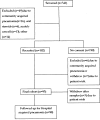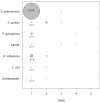Dental and microbiological risk factors for hospital-acquired pneumonia in non-ventilated older patients
- PMID: 25923662
- PMCID: PMC4414413
- DOI: 10.1371/journal.pone.0123622
Dental and microbiological risk factors for hospital-acquired pneumonia in non-ventilated older patients
Abstract
Methods: We obtained a time series of tongue/throat swabs from 90 patients with lower limb fracture, aged 65-101 in a general hospital in the North East of England between April 2009-July 2010. We used novel real-time multiplex PCR assays to detect S. aureus, MRSA, E. coli, P. aeruginosa, S. pneumoniae, H. influenza and Acinetobacter spp. We collected data on dental/denture plaque (modified Quigley-Hein index) and outcomes of clinician-diagnosed HAP.
Results: The crude incidence of HAP was 10% (n = 90), with mortality of 80% at 90 days post discharge. 50% of cases occurred within the first 25 days. HAP was not associated with being dentate, tooth number, or heavy dental/denture plaque. HAP was associated with prior oral carriage with E. coli/S. aureus/P.aeruginosa/MRSA (p = 0.002, OR 9.48 95% CI 2.28-38.78). The incidence of HAP in those with carriage was 35% (4% without), with relative risk 6.44 (95% CI 2.04-20.34, p = 0.002). HAP was associated with increased length of stay (Fishers exact test, p=0.01), with mean 30 excess days (range -11.5-115). Target organisms were first detected within 72 hours of admission in 90% participants, but HAP was significantly associated with S. aureus/MRSA/P. aeruginosa/E. coli being detected at days 5 (OR 4.39, 95%CI1.73-11.16) or 14 (OR 6.69, 95%CI 2.40-18.60).
Conclusions: Patients with lower limb fracture who were colonised orally with E. coli/ S. aureus/MRSA/P. aeruginosa after 5 days in hospital were at significantly greater risk of HAP (p = 0.002).
Conflict of interest statement
Figures



Similar articles
-
[Adult hospital acquired pneumonia: a multicenter study on microbiology and clinical characteristics of patients from 9 Chinese cities].Zhonghua Jie He He Hu Xi Za Zhi. 2012 Oct;35(10):739-46. Zhonghua Jie He He Hu Xi Za Zhi. 2012. PMID: 23289990 Chinese.
-
Hospital-acquired pneumonia in critically ill patients: factors associated with episodes due to imipenem-resistant organisms.Infection. 2005 Jun;33(3):129-35. doi: 10.1007/s15010-005-4021-8. Infection. 2005. PMID: 15940413
-
High prevalence of multidrug-resistant nonfermenters in hospital-acquired pneumonia in Asia.Am J Respir Crit Care Med. 2011 Dec 15;184(12):1409-17. doi: 10.1164/rccm.201102-0349OC. Epub 2011 Sep 15. Am J Respir Crit Care Med. 2011. PMID: 21920919
-
Hospital-acquired pneumonia: risk factors, microbiology, and treatment.Chest. 2001 Feb;119(2 Suppl):373S-384S. doi: 10.1378/chest.119.2_suppl.373s. Chest. 2001. PMID: 11171773 Review.
-
Epidemiology of healthcare-associated pneumonia (HCAP).Semin Respir Crit Care Med. 2009 Feb;30(1):10-5. doi: 10.1055/s-0028-1119804. Epub 2009 Feb 6. Semin Respir Crit Care Med. 2009. PMID: 19199182 Review.
Cited by
-
Oral health and the presence of infectious microorganisms in hospitalized patients: a preliminary observational study.Ann Med. 2022 Dec;54(1):1908-1917. doi: 10.1080/07853890.2022.2092895. Ann Med. 2022. PMID: 36073637 Free PMC article.
-
Multisite Evaluation of Toothbrushes and Microbial Growth in the Hospital Setting.Clin Nurse Spec. 2023 Mar-Apr 01;37(2):83-89. doi: 10.1097/NUR.0000000000000733. Clin Nurse Spec. 2023. PMID: 36799704 Free PMC article.
-
Complications and Pharmacologic Interventions of Invasive Positive Pressure Ventilation During Critical Illness.J Pharm Technol. 2018 Aug;34(4):153-170. doi: 10.1177/8755122518766594. Epub 2018 Mar 29. J Pharm Technol. 2018. PMID: 34860978 Free PMC article. Review.
-
Presence of non-oral bacteria in the oral cavity.Arch Microbiol. 2021 Aug;203(6):2747-2760. doi: 10.1007/s00203-021-02300-y. Epub 2021 Mar 31. Arch Microbiol. 2021. PMID: 33791834 Free PMC article. Review.
-
Oral Microbes in Hospital-Acquired Pneumonia: Practice and Research Implications.Crit Care Nurse. 2022 Jun 1;42(3):47-54. doi: 10.4037/ccn2022672. Crit Care Nurse. 2022. PMID: 35640896 Free PMC article. Review.
References
-
- Health Protection Agency. English National Point Prevalence Survey on Healthcare-associated Infections and Antimicrobial Use, 2011: Preliminary data Health protection Agency: London: 2012.
-
- Khasraghi FA, Lee EJ, Christmas C, Wenz JF. The economic impact of medical complications in geriatric patients with hip fracture. Orthopedics. 2003;26(1):49–53; discussion - PubMed
-
- Garcia-Alvarez F, Al-Ghanem R, Garcia-Alvarez I, Lopez-Baisson A, Bernal M. Risk factors for postoperative infections in patients with hip fracture treated by means of Thompson arthroplasty. Archives of Gerontology & Geriatrics. 2010;50(1):51–5. - PubMed
-
- Rothan-Tondeur M, Meaume S, Girard L, Weill-Engerer S, Lancien E, Abdelmalak S, et al. Risk factors for nosocomial pneumonia in a geriatric hospital: a control-case one-center study. Journal of the American Geriatrics Society. 2003;51(7):997–1001. - PubMed
Publication types
MeSH terms
Grants and funding
LinkOut - more resources
Full Text Sources
Other Literature Sources
Medical
Miscellaneous

